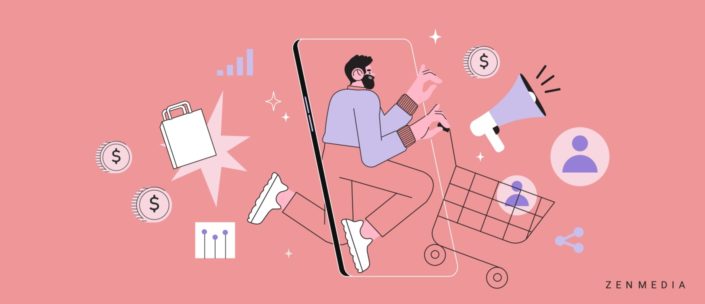B2B demand generation should be a staple of every 2023 B2B integrated marketing strategy. There’s serious competition in the B2B market and actually generating demand—rather than letting clients come to you—can strengthen conversion rates, lower cost per lead, and increase the customer lifetime value of your clients.
Ready to learn how to create a B2B demand generation strategy for your brand? Read on.
What is B2B demand generation?
It’s a common misconception that lead generation and demand generation are the same thing. In fact, demand generation is more like an umbrella term that encapsulates a number of actions that marketers and salespeople take, including lead generation (gaining prospective customers’ interest in your products or services), inbound marketing tactics, demand capture, and more.
Demand generation relies on building brand awareness and developing a relationship with an audience who wants to engage with your brand, consume your content, and maybe even share it with their friends and colleagues. Some tactics marketers use to generate demand include e-books, thought leadership, brand messaging, content marketing, social media marketing, influencer collaborations, and email marketing. As a tried and true staple of modern marketing, it’s no surprise that 79% of marketers say email is the most effective tactic for demand generation. However, as with all forms of B2B marketing, differentiation is crucial, and brands should employ a variety of tactics to meet goals more efficiently.
How to Develop a B2B Demand Generation Strategy
As with any part of a B2B marketing plan, when you develop a strategy (or strategies) for a demand generation campaign, you need to keep your objective in mind. Sure, your obvious objective is to generate demand, but we can do better than that! Get specific. What precisely are you generating demand for? With whom do you want to generate that demand?
While demand generation is typically a more broadly focused marketing strategy, you still need to define your parameters and goals. Here are some other considerations to ponder while developing your brand’s demand generation strategy.
Are you prioritizing digital-first content?
Creating content with digital-first execution in mind is really the only way forward. The precise platforms or media you use are up to you—well, up to your target audience, really—but prioritizing digital content in every facet of your digital campaign is the only way to get on the map in our digital-everything world.
One tactic you should incorporate into your digital-first strategy is creating and sharing high-quality B2B content. Whether that’s a well-researched blog post, an informative video, entertaining audio clips from your latest podcast, or a well-presented infographic from an industry data leader. Whether you create the resource or (responsibly) share it, high-quality, digital-first content is imperative to your brand’s B2B demand generation strategy.
Related reading: The Demand Generation: What It Is and Why You Want to Be A Part of It
How can you leverage data for account-based B2B marketing?
Your content isn’t the only thing that should be high-quality. The communications you have with prospects should be personalized with data gathered throughout the sales funnel. What are these consumers’ exact pain points? How is your brand the solution? Remember that your sales team needs to be able to communicate that solution clearly and confidently. By developing and executing a B2B demand generation strategy, you are priming your sales funnel for quality decision-makers to enter and be ushered through to your sales team.
So what internal data (or what data are you gathering during your demand gen and demand capture activities) can you implement into marketing tactics for your sales team to benefit from? What can you tell them about the prospect they are speaking with? What kind of ads did they engage with? What can marketing provide sales to bridge that gap? Leading us to…
What sales-enablement tools are you using to integrate marketing and sales?
Integrating marketing and sales teams is crucial for B2B demand generation success. These typically siloed departments need to speak each other’s languages. Using communication technology or project management software that provides real-time data helps keep everyone updated on the statuses of the latest leads—this is one way to avoid miscommunications or mix-ups. Having open dialogue is important because that is the only way sales and marketing can see eye to eye on what the other expects and can actually provide—and what they need to do the best job they can. Where the marketing department has previously supplied a multitude of marketing-qualified leads, your sales team might actually want just a handful of quality target accounts—real potential prospects they can approach.
So, what does sales-enabled marketing have to do with that? Well, sales-enablement tools can look like:
- Well-crafted email sequences highlighting your latest PR wins
- Product one-pagers or interactive exploratory sites to show your brand’s value/solution
- Learning to leverage dark social throughout the sales funnel
- Any material developed in collaboration between marketing and sales that seeks to improve the prospect’s experience to convert
To accomplish any of those sales-enablement practices, sales and marketing teams must work together. And the more real-world data that marketing can implement into strategies, the more effective the tactics will be for the salespeople in your company.
Related reading: What is Sales-Enabled PR?
How will you define what success looks like? What are your primary KPIs?
It’s important to know from the beginning what your objectives are and what metrics you deem most important to measure. Ideally, all B2B demand generation strategies should be measured for the volume they produce, the quality of the leads, and the conversion rates (conversions and speed of sales journeys). Set clear, measurable goals from the beginning, and you’re likely to find cross-team collaboration much more easily achieved.
B2B demand generation can give brands an advantage over their competitors as they gain brand awareness and trust. Are you ready to dive into the possibilities a demand gen strategy will bring to your company? Want to talk it through with the experts first? We’ve got you covered. Reach out.







